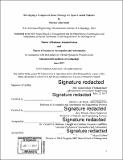| dc.contributor.advisor | Olivier L. de Weck and Roy Welsch. | en_US |
| dc.contributor.author | Good, Marissa Ann | en_US |
| dc.contributor.other | Leaders for Global Operations Program. | en_US |
| dc.date.accessioned | 2017-12-05T19:14:58Z | |
| dc.date.available | 2017-12-05T19:14:58Z | |
| dc.date.copyright | 2017 | en_US |
| dc.date.issued | 2017 | en_US |
| dc.identifier.uri | http://hdl.handle.net/1721.1/112486 | |
| dc.description | Thesis: S.M., Massachusetts Institute of Technology, Department of Aeronautics and Astronautics, in conjunction with the Leaders for Global Operations Program at MIT, 2017. | en_US |
| dc.description | Thesis: M.B.A., Massachusetts Institute of Technology, Sloan School of Management, in conjunction with the Leaders for Global Operations Program at MIT, 2017. | en_US |
| dc.description | Cataloged from PDF version of thesis. | en_US |
| dc.description | Includes bibliographical references (page 84). | en_US |
| dc.description.abstract | Launch vehicle hardware is traditionally very expensive to design, develop, produce and certify, because it must operate in extreme environments with high reliability. The result is that most hardware for NASA-funded launch vehicles is custom built to execute a specific mission on a single platform. In contrast to other industries (e.g. automotive), very few components are used across product platforms, a strategy known as reuse that has the potential to decrease the cost, schedule and risk of new product introduction. Budget constraints on NASA's next launch vehicle, the Space Launch System (SLS), brought about a desire to realize some of the benefits associated with reuse. However, the reuse strategy as employed has met limited success. This brings about the fundamental question: is there something inherently unique about launch vehicle design that prevents or limits reuse? If not are there strategies that can be implemented to realize the benefits of proactive reuse during launch vehicle design? The Boeing Company, the prime contractor of the SLS cryogenic stages, would like to develop a reuse approach as they begin work on the next phase of the SLS, the Exploration Upper Stage (EUS), to improve project affordability. To develop this approach, a case study of the Core Stage (CS) was performed to identify lessons learned, resulting in the following insights: 1. Capturing the benefits of reuse is enabled by modularity and platforms within single-vehicle architectures rather than across vehicles. The time offset between any two launch vehicles is too great (20-30 year product lifecycles) for reuse across vehicles. Furthermore, manned and unmanned vehicles carry different requirements which must be considered when evaluating the potential for shared assets. 2. Race should be defined as the baseline, rather than as an opportunity. This requires aligning incentives and architecting the organization to enforce reuse from the outset. 3. Plan for forward reuse. Consider future requirements when designing the current vehicle. Reuse will not happen by coincidence; it must be designed into the system. These insights form the basis of a reuse approach for the Exploration Upper Stage (EUS). In combination with some organization and process-based suggestions, a strategy to realize the benefits of reuse has been developed for the EUS and other future launch vehicles. | en_US |
| dc.description.statementofresponsibility | by Marissa Ann Good. | en_US |
| dc.format.extent | 84 pages | en_US |
| dc.language.iso | eng | en_US |
| dc.publisher | Massachusetts Institute of Technology | en_US |
| dc.rights | MIT theses are protected by copyright. They may be viewed, downloaded, or printed from this source but further reproduction or distribution in any format is prohibited without written permission. | en_US |
| dc.rights.uri | http://dspace.mit.edu/handle/1721.1/7582 | en_US |
| dc.subject | Aeronautics and Astronautics. | en_US |
| dc.subject | Sloan School of Management. | en_US |
| dc.subject | Leaders for Global Operations Program. | en_US |
| dc.title | Developing a component reuse strategy for space launch vehicles | en_US |
| dc.type | Thesis | en_US |
| dc.description.degree | S.M. | en_US |
| dc.description.degree | M.B.A. | en_US |
| dc.contributor.department | Leaders for Global Operations Program at MIT | en_US |
| dc.contributor.department | Massachusetts Institute of Technology. Department of Aeronautics and Astronautics | |
| dc.contributor.department | Sloan School of Management | |
| dc.identifier.oclc | 1011503866 | en_US |
